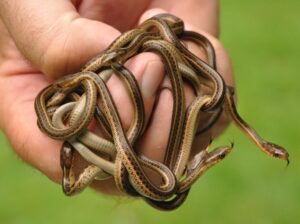Photography courtesy of Lowell Washburn, all rights reserved.

Spend much time exploring Iowa’s summer marshlands, and you’re likely to encounter a somewhat colorful reptile known as the red-sided garter snake. The species is named for the obvious red dash marks that occur between the snake’s dorsal and lateral stripes. The red scales vary in color and appear brightest on snakes that have recently shed their skins, a phenomenon that occurs two or more time during each growing season.

Unlike other Iowa snakes, garter snakes receive no legal protection. It is unfortunate that many of these harmless creatures are routinely killed on sight. Ask any garden hoe yielding Grannie why she just decapitated the red-sided who accidently crossed her path, and a mere shrug of the shoulders will be a likely response.
Although garter snakes pose no danger to humans, they will nevertheless defend themselves by vigorously biting and excreting a vile smelling musk when threatened. But once collected, they quickly settle down. No snake is quicker to tame. Once in captivity the snake will become completely docile and may eagerly accept offerings of nightcrawlers or minnows within a couple of days. Garter snakes provide an excellent tool for introducing young nature enthusiasts to the intriguing world of herpetology.

In sharp contrast to Iowa’s egg laying snakes, the red-sided bears live young – usually in late August or early September. Although older females may attain lengths approaching four feet, such specimens are rare. “Litter” sizes will vary depending on the age and size of the mother. Back in 1994, my son Matt temporarily housed a huge red-sided that delivered an incredible 109, seven-inch replicas of herself. In 2019, my friend Levi Reynolds gave me 30-inch female that he had collected near Clear Lake’s north shore. On August 13, that snake gave birth to more than 70 young. A couple of days later, I returned the snake and her youngsters to the same property where the female had been captured a few weeks earlier. These females were exceptional producers, of course. Most garter snakes produce broods that are much less dramatic in number.

Although red-sided garters are active from late April until early November, the climate tolerant snake is most active during warmer summer weather. Garter snakes are spectacular thermoregulators and often spend their early mornings basking atop warming rock piles or gopher mounds. Once body temperatures rise, the solar powered reptiles go on the hunt. Common prey items include leopard frogs, American toads, large insects and nightcrawlers. Amazingly, red-sided snakes are also somewhat adept at catching developing tadpoles and marshland fish species such as fathead minnows and sticklebacks. During the 1980’s I worked on a North Iowa Area Community College video portraying the life cycle of cavity nesting wood ducks at Mallard Marsh. Shortly after jumping her brood from the nest, one of the mother wood ducks led her newly hatched babies along the marsh’s plant laden shoreline. Things were progressing smoothly until a huge red-sided suddenly emerged from the vegetation. Before the ducks could react, the reptile grabbed a duckling and then quickly vanished back into the thick cover. The ambush was a bizarre incident and is the only time I have personally known of a garter snake successfully taking a bird.

 Susan Judkins Josten
Susan Judkins Josten Rudi Roeslein
Rudi Roeslein Elyssa McFarland
Elyssa McFarland Mark Langgin
Mark Langgin Adam Janke
Adam Janke Joe Henry
Joe Henry Sue Wilkinson
Sue Wilkinson Tom Cope
Tom Cope Kristin Ashenbrenner
Kristin Ashenbrenner Joe Wilkinson
Joe Wilkinson Dr. Tammy Mildenstein
Dr. Tammy Mildenstein Sean McMahon
Sean McMahon